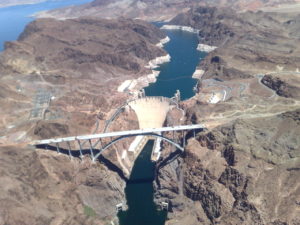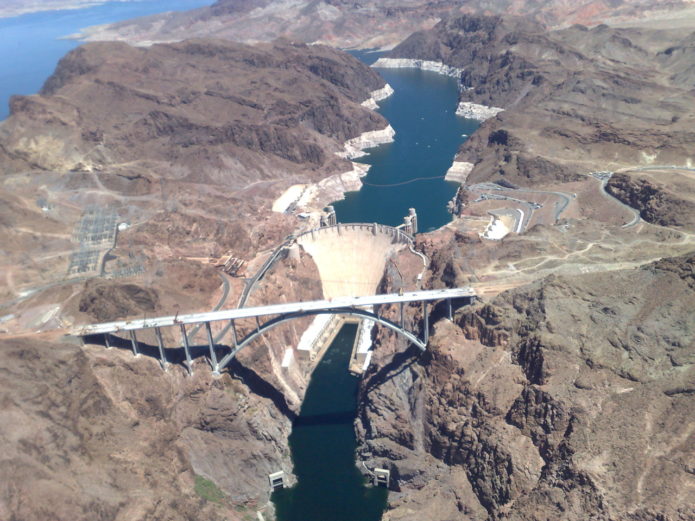
An aerial image of the Hoover Dam. Water levels at Lake Mead continue to hover at historic low levels and concern is a shortage declaration could come as early as 2020.
As those who follow Colorado River issues are likely aware, the Bureau of Reclamation has released its August figures on the possibility of a shortage declaration at Lake Mead, and the news is not good but it’s not devastating. First off, no shortage declaration is coming for 2019. You may recall that back in 2016 and 2017, the numbers indicated a shortage was likely as early as this year and in 2019—and that did not come to pass, largely thanks to nature and to the ongoing efforts of those who depend on the river for all or a portion of their water supply. However, this past year nature did not cooperate. The seasons were dry with little rainfall and worse, little snowfall accumulation. Back in April, the Bureau released statistics showed a 52 percent chance of a shortage declaration in 2020. After that release, there was still hope that the situation could improve, but that hasn’t happened, and the projected likelihood of a shortage has increased to 57 percent in 2020. That chance increases further if you speculate out to 2023.
While the difference between 52 percent and 57 percent may only seem like a few points—so not that significant of a change—when dealing with the Colorado River, these figures do matter. They are a reminder that drought is real, and that the Colorado River system is facing unprecedented low-levels brought on by what has been almost two decades of drought.
Today, we are perilously close to a shortage declaration. The Bureau of Reclamation would issue a shortage declaration if Lake Mead levels decreased to 1,075 feet above sea level elevation, which is considered the first trigger point for such a declaration. Levels 1,050 and 1,025 feet above sea level are additional triggers that would signal even more challenging times ahead. Such declarations matter because they would impact water supplies. California is protected from any supply reductions under a shortage. That is due to two factors—its senior priority status on the river, and the fact California reduced its dependence on the river under the Quantification Settlement Agreement (QSA), the cornerstone of which is the Water Transfer Agreement between Imperial Irrigation District and the San Diego County Water Authority. So, under a shortage, the States of Arizona and Nevada would take the cuts. However, if Lake Mead levels continue to decrease to levels beyond these triggers, California could find itself having to do more to generate water to keep the river in operation. These potential shortage declarations do matter and right now the river is only a few feet above the first trigger.
But, as stated, the news should not be viewed as devastating.
What it should be is a call to action, and that is exactly what it has become. But keep in mind this is not the first time that those who depend on the river have had to act to protect supplies. If history teaches anything about the river, it is that states and water agencies have an ability to come together and resolve water supply issues. The QSA is certainly one example. The 2007 interim guidelines are another in that they coordinated operations of Lake Mead and Lake Powell. The international agreements with Mexico in the form of Minutes is yet one more example. The most notable in recent years include Minute 318, which extended humanitarian aid to Mexico after a 2010 earthquake, Minute 319, which continued that aid and further coordinated international river operations, and more recently Minute 323, which takes into consideration how a shortage would be shared internationally.
In the end, the numbers recently released by the Bureau on the potential for a shortage declaration are sobering. But, as has been said in this blog in times past, action more than fear is what is needed to ensure the continued operation of the river. California water agencies must remain watchful to ensure all parties do their part as California, under the QSA, has already taken considerable steps to conserve water and support the river. It is very likely that there will be more actions to come in the years ahead. What form those actions take is yet to be seen, but this blog writer tends to think that agencies and states will find a resolution that ensures all water users maintain a balanced supply.
That said, it remains incumbent upon us all to stay vigilant and engaged—but those of you who follow this issue already know that. Stay tuned for updates on the river’s condition and any actions on the part of agencies to prevent a shortage declaration.
